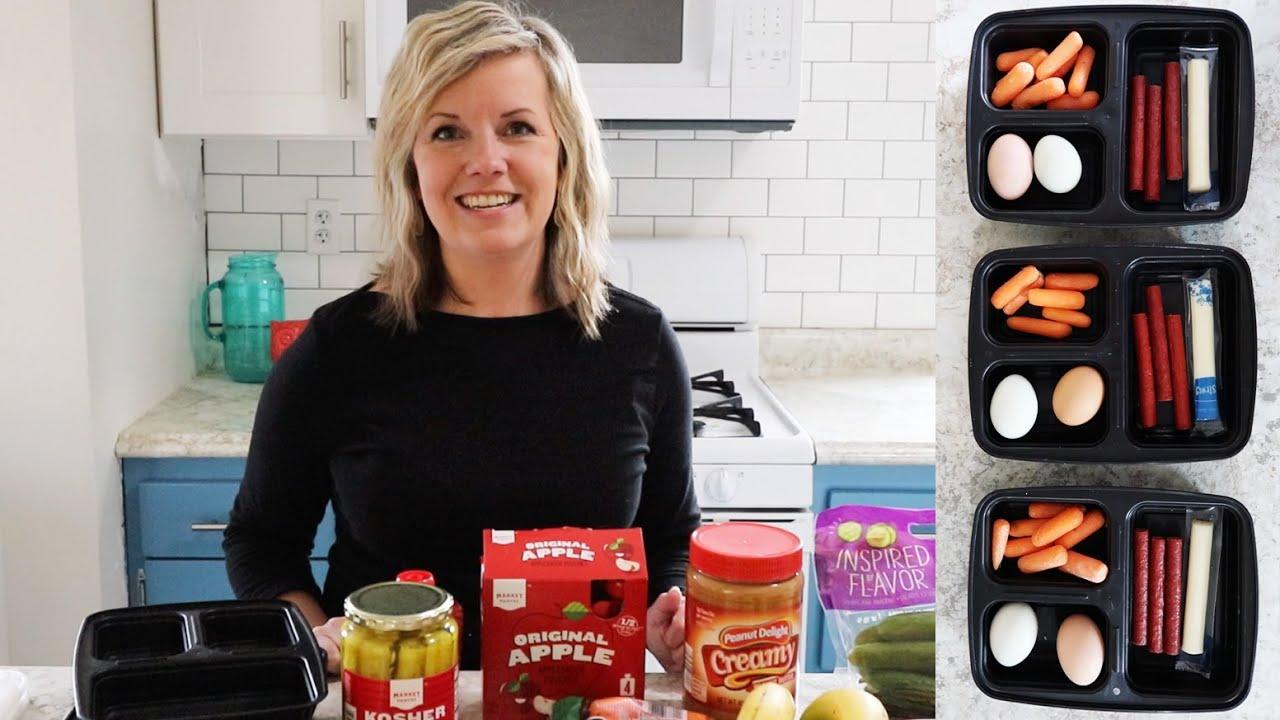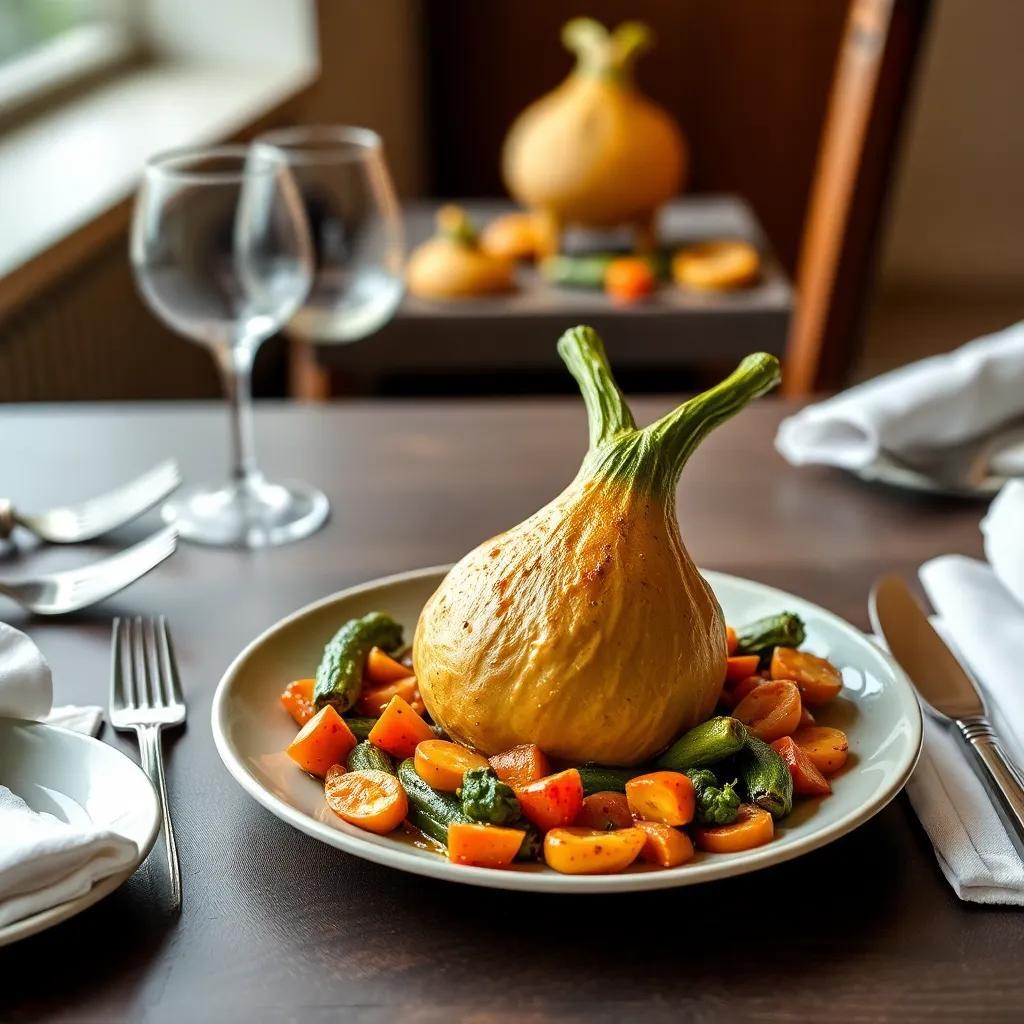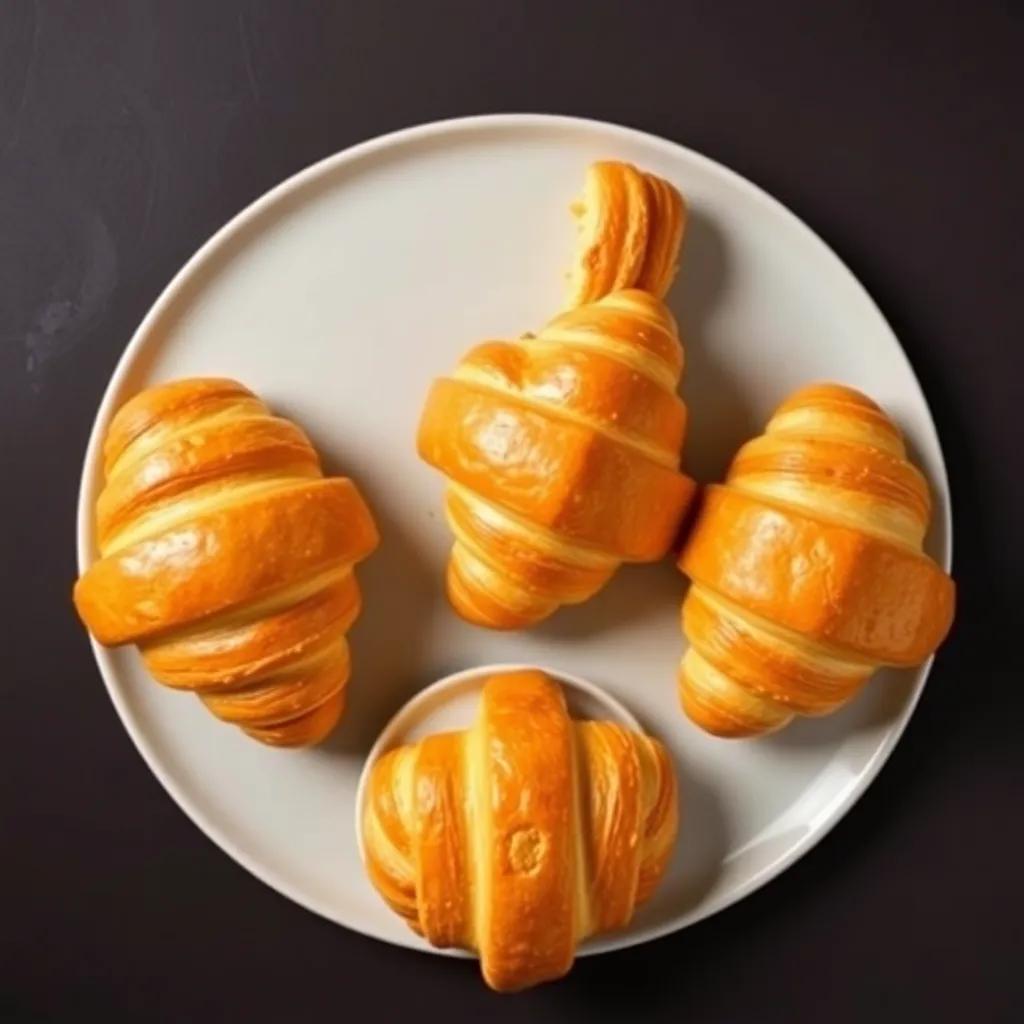Flaky Perfection: Easy Homemade Croissants for Every Baker

Flaky Perfection: Easy Homemade Croissants for Every Baker
🌍 Cuisine: French
⚙️ Difficulty: Medium
Ingredients
Nutrition Facts
~320
Instructions
- In a small bowl, dissolve the yeast in lukewarm milk and let it sit for 5 minutes until frothy.
- In a large mixing bowl, combine flour, sugar, and salt. Make a well in the center and pour in the yeast mixture. Mix until a dough forms.
- Knead the dough on a lightly floured surface for about 8-10 minutes until smooth and elastic.
- Shape the dough into a ball, place it in a lightly greased bowl, cover with plastic wrap, and refrigerate for at least 1 hour.
- Meanwhile, prepare the butter block by placing the cold butter between two sheets of parchment paper and pounding it with a rolling pin into a 7×7 inch square. Chill it in the refrigerator.
- Roll the chilled dough into a 10×10 inch square. Place the butter block diagonally in the center of the dough square. Fold the dough corners over the butter to encase it completely.
- Roll the dough and butter packet into a 20×10 inch rectangle. Fold the dough into thirds like a letter (this is the first turn). Wrap in plastic wrap and chill for 30 minutes.
- Repeat the rolling and folding (turn) process two more times, chilling the dough for 30 minutes between each turn to create layers.
- After the final turn, roll the dough into a 20×10 inch rectangle. Cut the dough into 8 triangles.
- Roll each triangle from the wide base toward the point, curling slightly to form a crescent shape, and place on a baking sheet lined with parchment paper.
- Cover the croissants loosely with a cloth and let them proof at room temperature for 1 to 1.5 hours, until doubled in size.
- Preheat your oven to 400°F (200°C).
- Whisk the egg with 1 tablespoon water and brush the croissants gently with the egg wash.
- Bake croissants in the preheated oven for 12-15 minutes, or until golden brown and flaky.
- Cool on a wire rack before serving for best texture and flavor.
Serving Suggestions
- Serve warm with butter and your favorite jam or honey.
- Pair croissants with a hot cup of coffee or tea for a perfect breakfast.
- Use croissants to make decadent breakfast sandwiches with eggs, cheese, and ham.
- Taste delicious with sweet spreads like Nutella or almond butter.
- Enjoy alongside fresh fruit or a light mixed greens salad for brunch.
- Toast leftovers lightly to refresh flakiness and pair with melted cheese.
- Turn into mini desserts by adding chocolate or fruit filling before baking.
Table of Contents
- Intro
- Ingredient Notes
- Tips & Variations
- Leftovers & Storage
- Behind the Recipe
- FAQ
- Let’s Get Cooking!

Intro
There’s something truly magical about biting into a freshly baked croissant—its delicate, golden layers melting effortlessly into buttery flakes that dance on your palate. This recipe brings that bakery charm right into your own kitchen, offering an approachable guide to crafting croissants that boast that signature crisp exterior and soft, tender inside. Whether you’re an adventurous home baker eager to conquer laminated dough for the first time or someone looking to elevate weekend brunch with a touch of French flair, these croissants are designed to delight without overwhelming.
Perfect for leisurely mornings, celebratory brunches, or even as a thoughtful homemade gift, these croissants bring warmth and a touch of elegance to any table. They pair wonderfully with everything from a simple smear of butter to savory fillings or sweet jams, making them a versatile canvas for your favorite flavors. Embracing the rhythm of resting and folding, the process transforms humble ingredients into layers of flaky perfection—each step rewarding you with a deeper connection to the art of baking. So take a little extra time, enjoy the hands-on experience, and prepare to impress friends and family with pastries that look—and taste—like they came straight from a Parisian boulangerie.
Ingredient Notes
When it comes to croissants, a few key ingredients stand out not just for their flavor, but for the critical roles they play in achieving that iconic flaky texture and rich taste. Understanding these components can elevate your baking and help troubleshoot any hiccups along the way.
All-Purpose Flour
While some purists swear by bread flour or pastry flour for croissants, all-purpose flour strikes a perfect balance for home bakers. Its moderate protein content (typically 10-12%) provides enough gluten structure to create the framework for those delicate layers without making the dough tough. When shopping, look for unbleached all-purpose flour to avoid chemical aftertastes and ensure better dough performance. If you’d like an even lighter crumb, pastry flour can be used, but you might sacrifice a bit of strength in the dough, which calls for gentler handling during rolling and folding.
Unsalted Butter, Cold and High Quality
Butter is undeniably the heart of every croissant’s flavor and flakiness. Using unsalted butter lets you control the salt in the dough precisely. Choose a European-style butter with higher fat content (around 82% or more) for richer pockets of flavor and a tender crumb. Cold butter is essential to maintain distinct layers during lamination; soft or room-temperature butter will merge too quickly with the dough, resulting in less pronounced flakiness. If European-style butter isn’t available, a good-quality, regular unsalted butter will still deliver excellent results. For those with dietary restrictions, vegan butter alternatives can be experimented with but watch for water content and consistency to avoid soggy layers.
Active Dry Yeast
Yeast is what brings life and lightness to the dense, buttery dough. Active dry yeast requires proofing in lukewarm milk to wake up and produce the carbon dioxide needed to puff the dough during proofing and baking. Be sure not to use water that’s too hot, as this will kill the yeast, nor too cold, which slows activation. If you prefer, instant yeast can be substituted—skip the proofing by mixing it directly with the dry ingredients, though rising times may vary slightly.
Whole Milk, Lukewarm
Milk adds tenderness and subtle sweetness to the dough, complementing the butter’s richness. Whole milk’s fat content helps tenderize the gluten network, preventing overly chewy croissants. Lukewarm temperature (about 100°F/38°C) activates the yeast gently and aids in proper dough fermentation. While water or low-fat milk can be used in a pinch, expect the texture and flavor to be somewhat less indulgent.
By choosing these ingredients thoughtfully and understanding their unique contributions, your croissants will develop those irresistible layers and buttery aroma that define flaky perfection. Small tweaks here and there—like experimenting with different flour blends or butter brands—offer a wonderful way to make this classic recipe uniquely your own.
Tips & Variations
Mastering homemade croissants is as much about technique and patience as it is about ingredients. Here are some pro tips and clever variations to help you customize this flaky French favorite to suit your kitchen style, flavor preferences, and dietary needs.
- Keep Everything Cold, But Not Frozen: Temperature control is key when laminating dough. Your butter and dough should be chilled but pliable—not frozen solid—to create those distinct, delicate layers. If the butter breaks through the dough or feels too hard to roll, let it rest at room temperature for a few minutes before continuing. On hot days, refrigerate your rolling surface and rolling pin for extra control.
- Use a Light Touch When Rolling: Resist the urge to press too firmly during rolling and folding. Gentle, even strokes preserve the butter layers and prevent it from seeping into the dough. Too much pressure can cause uneven layers or soggy spots rather than crisp, airy flakiness.
- Don’t Skip the Resting Periods: Each chill period after folding lets the gluten relax and the butter to firm up, preventing shrinkage and helping create those signature airy pockets. Rushing this process might save time but will compromise texture and rise.
- Egg Wash Alternatives: For a shiny croissant crust, the classic egg wash is ideal. However, for vegans or egg allergies, try brushing with aquafaba (the liquid from canned chickpeas) mixed with a touch of maple syrup for gentle browning. Alternatively, a light coating of warmed almond milk can add some golden color.
- Flavor Variations: Elevate your croissants with fillings or toppings:
– Sweet: Add a thin spread of chocolate or almond paste inside before rolling for pain au chocolat or almond croissants. Sprinkle pearl sugar or sliced almonds on top before baking.
– Savory: Fold in grated cheese, ham, or herbed cream cheese for a satisfying brunch twist. Fresh herbs like thyme or chives can also be gently pressed into the dough before baking.
– Infused Butter: Mix softened butter with zest (lemon, orange), cinnamon, or garlic before creating your butter block for subtle, aromatic layers.
- Gluten-Free & Vegan Adaptations:
– Gluten-free croissants are tricky because the lamination relies heavily on gluten’s elasticity. However, experimenting with a high-quality gluten-free flour blend combined with xanthan gum or psyllium husk can yield decent results. Expect a crumb that’s more tender than chewy.
– For vegan croissants, replace butter with a firm, high-fat vegan butter substitute. Use plant-based milk (like oat or soy) warmed to activate yeast, and swap the egg wash for a vegan alternative as above. Keep chilling times intact to maintain lamination integrity.
- Swapping Ingredients Without Sacrificing Texture:
– Milk can be replaced with full-fat plant milks, but avoid watery options that might weaken the dough.
– Sugar can be reduced slightly or substituted with coconut sugar or maple syrup, though flavor and browning may shift subtly.
– Salt is crucial, so tweak sparingly unless dietary requirements dictate otherwise.
- Shaping Ideas: If the classic crescent shape feels intimidating, try rectangular croissants or little rolls for an easier shape that still bakes up beautifully.
Remember, every baker’s croissant will have its own unique charm—embrace small imperfections as signs of authentic homemade goodness. With practice, these tips will help your croissants develop not only flaky layers but also a deeper connection to the craft that makes baking so rewarding.
Leftovers & Storage
Once your homemade croissants have worked their flaky magic fresh from the oven, you may wonder how best to keep that tender, buttery goodness around for later enjoyment. Proper storage not only preserves the delicate layers but also ensures you can savor your baking efforts without waste.
To keep leftover croissants fresh for the short term, allow them to cool completely on a wire rack to prevent condensation, which can lead to sogginess. Once cooled, store them in an airtight container or resealable plastic bag at room temperature for up to 1 to 2 days. This will maintain their flaky crust and soft crumb, though they are best enjoyed the same day or day after baking.
If you’re planning to save croissants for longer than a couple of days, refrigeration is an option but comes with a trade-off: the fridge tends to dry out pastries and can diminish flakiness. If you must refrigerate, wrap each croissant individually in plastic wrap or place them in a sealed container to minimize moisture loss, and consume within 3 to 4 days. Before eating, gently warm croissants in a low oven (about 300°F/150°C for 5–7 minutes) or toaster oven to revive their flaky texture.
For extended storage, freezing is the most reliable method to lock in freshness and flavor. To freeze croissants, wrap each one tightly in plastic wrap, then place them in a freezer-safe zip-top bag or airtight container to prevent freezer burn. Properly stored, croissants will keep well for up to 2 months. When ready to enjoy, thaw them overnight in the refrigerator or at room temperature for a few hours. Reheat in a preheated oven at 350°F (175°C) for 8–10 minutes until warmed through and crisp on the outside—this quick refresh brings back that just-baked charm better than microwaving, which can make them chewy or tough.
If you anticipate making croissants in bulk or want to enjoy fresh baking multiple days in a row, this recipe lends itself beautifully to meal prep. You can prepare and shape the croissants ahead of time, freeze them unbaked on parchment-lined trays, then transfer to a bag once firm. When you’re ready to bake, pop them straight from the freezer onto a baking sheet, let them proof covered at room temperature for 1.5 to 2 hours (longer than fresh dough), then brush with egg wash and bake as usual. This strategy lets you enjoy fresh-from-the-oven croissants on demand without the full rolling and laminating process each time.
If packing croissants for on-the-go breakfasts or lunches, wrap them tightly in parchment or wax paper, then place in a rigid container to avoid crushing those flaky layers. Avoid plastic wrap alone, as it can trap moisture and soften the crust, making the croissant less delightful.
In all cases, keep in mind that croissants taste best fresh and warm, so whenever possible, revive your leftovers with gentle reheating. A little oven TLC brings the flaky layers back to life, rekindling the irresistible buttery crunch that makes homemade croissants so special.
Behind the Recipe
Croissants carry with them a rich heritage steeped in both legend and culinary tradition, tracing their flaky layers back to a fascinating blend of culture and innovation. While often celebrated as an icon of French baking, the origins of the croissant are believed to reach back to 17th-century Vienna. It is said that Viennese bakers crafted a crescent-shaped pastry called the “kipferl” to commemorate a victorious defense against invading Ottoman forces—the crescent symbolizing the Ottoman flag. This shape and concept were eventually embraced and transformed by French pastry chefs, who introduced the delicate laminated dough technique that defines the modern croissant’s lightness and buttery texture.
For home bakers, this recipe bridges centuries of pastry craft and invites you to participate in a timeless culinary ritual. Crafting croissants from scratch means engaging intimately with the dough’s rhythm—mixing, resting, folding—each step mirroring the care and patience that professional boulangeries treasure. There’s something quietly rewarding in seeing those simple ingredients evolve into golden, layered crescents, knowing you’ve echoed a small part of baking history.
On a personal note, many find the process meditative—the tactile experience of rolling and folding butter into dough can be soothing, and the aroma filling the kitchen is nothing short of intoxicating. Homemade croissants also carry a sense of occasion, turning any morning ordinary into one with heritage and warmth. Whether you’re making them for a weekend brunch, a family gathering, or a special treat, these croissants celebrate tradition, craft, and the joy of sharing something lovingly made.
In essence, this recipe not only delivers flaky pastries but invites you into a story of cultural exchange and artisanal dedication—one buttery layer at a time.
FAQ
Can I use all-purpose flour instead of pastry flour for my croissants?
What’s the best way to store croissants to keep them fresh?
Can I make croissants ahead of time and freeze the dough instead of the baked croissants?
Is it possible to make croissants dairy-free or vegan?
How do I know if I’ve laminated the dough enough?
Can I add fillings like chocolate or ham and cheese to these croissants?
Let’s Get Cooking!
There’s something truly magical about pulling golden, flaky croissants fresh from your own oven—a simple recipe turning into a delicious ritual that anyone can master. With just a little patience and love, these homemade croissants bring a taste of Paris right into your kitchen, perfect for breakfast, brunch, or any time you crave a buttery treat.
We’d love to hear how your croissant journey unfolds! Drop a comment below, share your favorite variations, or give the recipe a rating to let us know how it went. Happy baking, and may every bite be as flaky and wonderful as you imagined!












